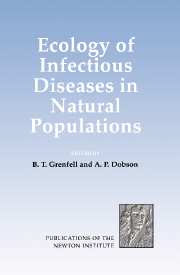Book contents
- Frontmatter
- Contents
- List of Participants
- Introduction
- BROAD PATTERNS AND PROCESSES
- Impact of Infectious Diseases on Wild Animal Populations: a Review
- Microparasites: Observed Patterns
- Mathematical Models for Microparasites of Wildlife
- Microparasite Group Report
- Macroparasites: Observed Patterns
- Mathematical Models for Macroparasites of Wildlife
- Macroparasite Group Report
- Critical Evaluation of Wildlife Disease Models
- PATHOGENS, INSECTS AND PLANTS
- IMPACT OF ECOLOGICAL AND GENETIC HETEROGENEITY
- Glossary
Macroparasites: Observed Patterns
Published online by Cambridge University Press: 22 January 2010
- Frontmatter
- Contents
- List of Participants
- Introduction
- BROAD PATTERNS AND PROCESSES
- Impact of Infectious Diseases on Wild Animal Populations: a Review
- Microparasites: Observed Patterns
- Mathematical Models for Microparasites of Wildlife
- Microparasite Group Report
- Macroparasites: Observed Patterns
- Mathematical Models for Macroparasites of Wildlife
- Macroparasite Group Report
- Critical Evaluation of Wildlife Disease Models
- PATHOGENS, INSECTS AND PLANTS
- IMPACT OF ECOLOGICAL AND GENETIC HETEROGENEITY
- Glossary
Summary
Introduction
The parasitic helminths and arthropods (ticks and fleas) are usually classified as macroparasites. The definition embraces the nematodes, cestodes, trematodes, acanthocephalans and the lice, fleas and ticks (Anderson and May 1979). In these species, reproduction usually occurs via the transmission of free-living infective larval stages, although many species have complex life cycles involving several obligatory host species. Macroparasites do not usually have direct reproduction within their definitive hosts, but asexual reproduction occurs in the intermediate hosts of the digenean trematodes and some cestodes and nematodes. When compared with the microparasites (the protozoans, viruses and bacteria), the macroparasites are relatively large, have long generation times and are immunologically characterised by a diversity of antigens. Infections by macroparasites are generally chronic leading to morbidity rather than mortality (see Lloyd this volume). It is therefore important to consider the sub-lethal effects of macroparasites on host fitness rather than more obvious lethal effects as both have important consequences for the dynamics of the interaction between the host and parasite populations.
Despite the very large number of parasites known to infect wild animals, relatively few ecologists have investigated the role of parasitic helminths and arthropods in regulating host abundance or distribution. This is surprising when one considers the numerous studies that have investigated the regulatory role of other natural enemies such as parasitoids and predators (Crawley 1992). On the one hand, ecologists and wildlife managers have traditionally seen parasites as benign symbionts living in equilibrium with their host. When environmental factors disturbed this careful balance, then the epidemic outbreaks of macroparasites could cause massive host mortalities, but these were thought to be unusual exceptions to this general rule.
- Type
- Chapter
- Information
- Ecology of Infectious Diseases in Natural Populations , pp. 144 - 176Publisher: Cambridge University PressPrint publication year: 1995
- 76
- Cited by

